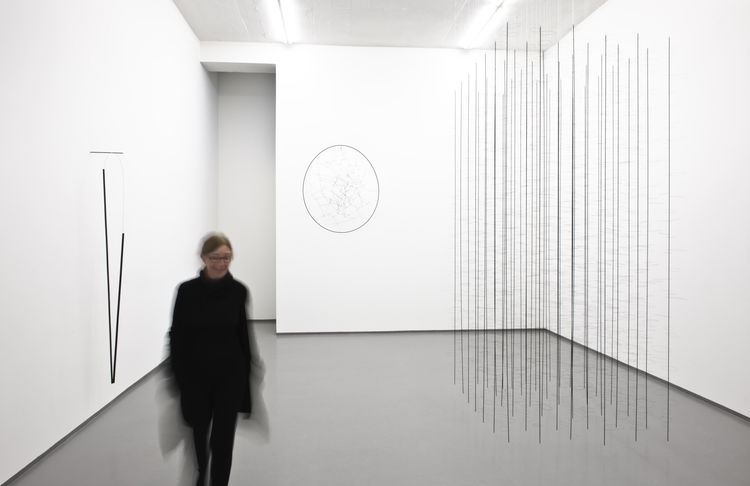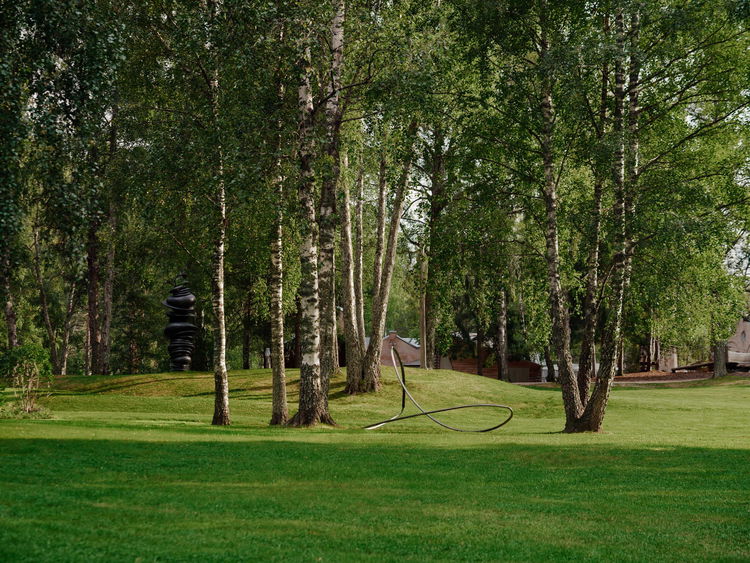Tone Vigeland

Portrait Tone Vigeland. Photo: Morten Andenæs.
Tone Vigeland (b. 1939) has been a notable figure in Norwegian art since the late 1950s, and her jewellery has placed her in the front rank of Norwegian artisans. Few have equalled her in conquering both her own country and the international arena through representation in museums and collections, prestigious exhibitions and honours and prizes.
At the same time, fine art has always been an important reference point to her, and from early on she was concerned that her jewellery pieces should work both in relation to the body and as free-standing objects. Her works have been regarded in that way in their settings too, and from 1967 and on her jewellery has usually been displayed beside pictorial art. Yet it was not until almost 30 years later, in 1996, that she started working with reliefs and freestanding works. A short time later jewellery was laid aside, and she devoted herself fully to work with sculpture.
When Tone Vigeland made that leap over into the physical space, it was for good. Norwegian sculpture had gained a new voice. Since then her production has been rapidly increasing and exhibitions have been numerous, followed by several public commissions, and it was as a sculptor that she was invited to be the Festival Artist in Bergen in 2014.
Vigeland’s jewellery and sculpture are closely linked, however, and will always be so, as part of one oeuvre – something she herself also stresses. The evolution that Vigeland has undergone since the middle of the 1990s is in many ways symptomatic of what has happened to the majority of craft artists in Norway and Europe in the same period. Material-based contemporary art operates effortlessly within many different contexts, and in recent years we have seen a renewed interest in handicrafts and a re-evaluation of modernist vocabulary on the contemporary arts scene. Vigeland’s output in recent years is on the one hand in dialogue with these tendencies, and on the other hand a natural extension of decades of accumulated material knowledge and sensitivity to form which is constantly taking new turns in her art – regardless of which categories one chooses to place the works in. 2
Around 2005 Vigeland stepped out into space with her delicate constructions in steel and silver; at first attached to the wall with fine, almost invisible threads, and then in works that found their way almost on tiptoe out onto the floor. But then too the works had a direct relationship to the wall.
This also applied to her experimentation with smaller works confined to a plint or a pedestal. Like poetic, three-dimensional drawings, they embrace the space and let themselves be filled by it. Here there is an equal play between the material that defines the space and the empty space that enters in as part of the sculpture. This method of using the space belongs to modernism, and was first developed by Naum Gabo and the Constructivists in the 1910s and 1920s. Vigeland’s clean-cut formalism points both backwards in time and inwards into contemporary art. Modernism’s sculptural tradition, which was often invoked in the discussion of her jewellery art has now also become her own arena. Vigeland’s position is interesting because she navigates in dialogue with a number of such categories at the same time as she meticulously defines her own place in this landscape. Her sculptures can be seen as a natural reworking of the innate landscapes of her earlier jewellery, and at the same time one can see how she has gained inspiration from a number of other artists and trends. Artists who share Tone Vigeland’s sensitivity to form and interest in material exploration can be found both in the history of art, in her own generation and among younger artists.
Turning to the domestic art scene, the lines of connection and points of contact are many, but Tone Vigeland has never been part of or accommodated herself to any Norwegian sculptural tradition, be it the figurative school of Per Palle Storm and Nils Aas, or the non-figurative one of Arnold Haukeland and Aase Texmon Rygh. One artist she herself gladly highlights is however Jan Groth. It was not just age, nationality and friendship that bound these two artists together. Their art is difficult to compare and they were influenced by different landscapes, but they had a common foundation in the perfectionism, intensity and consistency that characterise the work of both.
In connection with the Festival Exhibition of 2014, Vigeland worked on investigating the potential of steel and steel wire. The slender steel strings were drawn out between her hands and formed into the most delicate patterns, held together by 3 thicker wires, playing as if on strings. The way from here to the straight line was not a long one. In this way Vigeland explored material possibilities and sculptural challenges in parallel with different approaches, but still with the wall surface as an active partner even where the sculptures hover freely in space and the walls no longer have an anchoring role.
Text by Karin Hellandsjø

Portait Tone Vigeland. Photo: Guri Dahl.
